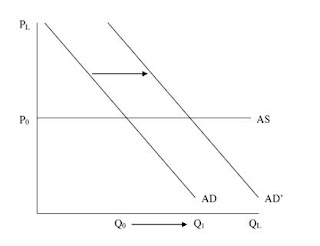 |
| Why can't Augie's campus be this inspiring? Inside the University of Sydney's Quadrangle. |
On Tuesday, January 11 we returned to the University of Sydney for two guest lecturers. In the morning, we heard from Geoff Dow, a political economist, who spoke about the differences between Australian macroeconomic performance and that of other countries. After lunch we heard from Frank Stilwell, University of Sydney faculty member, who gave an overview of why Australia is considered “the lucky country” and how the country survived the global financial crisis.
Professor Dow used many variables to compare Australia with the rest of the world, such as unemployment, GDP per capita and the Human Development Index, and public sector investment.
According to Professor Dow’s lecture and handout, public sector investment (spending on long-term assets such as roads, bridges, dams, and power plants) as a portion of total GDP (Gross Domestic Product) is currently less than 2% in Australia. Lack of public investment in education, health systems, and infrastructure is lower than a 28-nation average of 2.9%. In response to the global financial crisis, the Australian government’s stimulus package gave every household $1,000 in order to augment the level of consumer spending. Geoff Dow believes that instead of giving households money to buy consumer goods such as imported plasma televisions, the government should have invested more in public infrastructure, which generates long-term benefits to the public. Spending the stimulus money on private goods will not benefit Australia in the future.
 |
| Professor Nesiba presenting Geoff Dow with a token of our appreciation. |
Unemployment has declined since 2000 because of the Australian mining boom. It seems to be the case that a high percentage growth in total GDP is a result of low unemployment. In other words, when the work force is larger, output should increase. However, this is not always true. From the 1970s-1990s, Australian unemployment was 7.4% (quite high), but growth was 2.7% (higher than the OECD average). High growth and high unemployment occurred simultaneously. This is good for Australia’s economic outlook. On the other hand, Switzerland experienced low unemployment (1.4%) during this time period, but only had growth of 1.3%. Both Switzerland and Australia’s situations refute the common case of high growth coming as a result of low unemployment, or vice versa.
In a list of 15 rich countries, Australia is ranked sixth for 2010 GDP per capita. Norway, Singapore, America, Netherlands, and Canada are the top five countries on this list. However, when the same 15 rich countries are ranked according to the 2010 Human Development Index, Australia is ranked second, only behind Norway. This index considers factors such as life expectancy, amount of schooling, and per capita income. Singapore (2nd on GDP per capita ranking) plummeted to 15th on the Human Development Index ranking. This high ranking on the HDI indicates that Australia is a well-developed country and has a high standard of living. In fact, Australians worked an annual average of 1,690 hours in 2009, compared to 1,802 annual average hours worked in America.
Concerning GDP, unemployment, and inflation since World War II, Australia has gone through the both the boom and bust phases of the business cycle. From Evan Jones (last week’s guest lecturer), we learned that in the 1950s, there was an economic boom, in which a massive power and irrigation infrastructure expansion took place, thus providing post-war European migrants a material livelihood. In the 1960s, a massive resource boom began which was characterized by exports to Japan. Both a decay and restructuring of the manufacturing industry and an agricultural crisis occurred in the 1980s. A general recovery occurred because of a massive prolonged resources boom and exporting to China took place in 1990s and 2000s.
According to Evan Jones’ handout, as of 2009-10, Australia’s primary export partners are China, Japan, Korea, India and the United States. Australia’s primary import partners are China, United States, Japan, Thailand, and Singapore. Their top exports include coal, iron ore, education-related travel services, and personal travel (tourism).
 | |
| Frank Stilwell, our afternoon lecturer. |






















